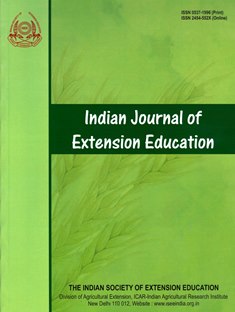Economic Perspective of Trends and Determinants of Paddy Stubble Burning in North Western India
DOI:
https://doi.org/10.48165/IJEE.2025.61425Keywords:
Paddy stubble burning, North Western India, Mann-Kendall test, Panel regression, Happy seederAbstract
During the paddy harvesting season in North-Western India, a significant smog problem occurs due to the unhealthy practice of stubble burning, which also reduces soil fertility. The government has implemented various efforts to lessen its severity. By using tabular analysis of burning events, this study found that the number of such events decreased from 2016 to 2021 in North-Western India. The Mann-Kendall test indicated a negative trend in burning events for the three states of Punjab, Haryana, and WUP. In Punjab, about 49% of the paddy area is burned, with the growth rates of the burnt area and paddy area being nearly equal. Conversely, in Haryana, only 17% of the paddy area is burned, but its burnt area is growing at a faster rate than the paddy area itself. Districts like Firozepur, Faridkot, Patiala, and Sangrur in Punjab, along with Fatehabad, Kurukshetra, and Karnal in Haryana, require special attention due to their relatively high percentage of paddy area subjected to burning. Panel regression analysis suggests that cultivating potato and basmati rice can reduce the paddy area affected by burning.
Downloads
References
Athare, P. G., Singh, D. R., Kumar, N. R., Jha, G. K., Venkatesh, P., & Chakrabarti, B. (2023). Spatio-temporal analysis of rainfall and temperature trends in Maharashtra State, India (Asia). International Journal of Environment and Climate Change, 13(9), 552–561. https://doi.org/10.9734/ijecc/2023/v13i92270
Bhuvaneshwari, S., Hettiarachchi, H., & Meegoda, J. N. (2019). Crop residue burning in India: Policy challenges and potential solutions. International Journal of Environmental Research and Public Health, 16(5), 832. https://doi.org/10.3390/ijerph16050832
Bimbraw, A. S. (2019). Generation and impact of crop residue and its management. Current Agriculture Research Journal, 7(3), 304– 309. https://doi.org/10.12944/carj.7.3.05
CREAMS Portal, ICAR-IARI. Consortium for Research on Agroecosystem Monitoring and Modeling from Space. http:// creams.iari.res.in
Debangshi, U., & Ghosh, P. (2022). Rice wheat cropping systems constraints and strategies: A review. Plant Archives, 22(1), 09725210.
Hiloidhari, M., Baruah, D. C., Kumari, M., Kumari, S., & Thakur, I. S. (2019). Prospect and potential of biomass power to mitigate climate change: A case study in India. Journal of Cleaner Production, 220, 931-944.
Huria, A., Bhardwaj, N., & Basera, N. (2021). Profile Characteristics of the Farmers Showing Stubble Burning Behaviour in Punjab. Asian Journal of Agricultural Extension, Economics & Sociology, 39(2), 23-39.
Jambagi, R., Singh, D. R., Singh, A., Venkatesh, P., Nain, M. S., & Panghal, P. (2023). Are happy seeder and Pusa decomposer potential options for sustainable ways of paddy straw management. Indian Journal of Extension Education, 59(3), 132- 137. http://dx.doi.org/10.48165/IJEE.2023.59325
ECONOMIC PERSPECTIVE OF TRENDS AND DETERMINANTS OF PADDY STUBBLE BURNING 159
Jatav, S. S. (2024). Factors affecting adoption of climate-smart agriculture practices: evidence from Uttar Pradesh, India. Indian Journal of Extension Education, 60(2), 27-32. https://doi.org/ 10.48165/IJEE.2024.60205
Kaushal, L. A., & Prashar, A. (2021). Agricultural crop residue burning and its environmental impacts and potential causes–case of northwest India. Journal of Environmental Planning and Management, 464–484. https://doi.org/10.1080/09640568.2020. 1767044
Kumar, A., Kumar, A., & Kumari, P. (2022). Income diversification: A way towards attracting rural youth in agriculture. Indian Journal of Extension Education, 58(4), 107-112. https://doi.org/ 10.48165/IJEE.2022.58422
Lan, R., Eastham, S. D., Liu, T., Norford, L. K., & Barrett, S. R. (2022). Air quality impacts of crop residue burning in India and mitigation alternatives. Nature Communications, 13(1), 6537. https://doi.org/10.1038/s41467-022-34093-z
Mehmood, K., Chang, S., Yu, S., Wang, L., Li, P., Li, Z., & Seinfeld, J. H. (2018). Spatial and temporal distributions of air pollutant emissions from open crop straw and biomass burnings in China from 2002 to 2016. Environmental Chemistry Letters, 16(1), 301-309.
Nagar, P. K., Sharma, M., & Das, D. (2019). A new method for trend analyses in PM10 and impact of crop residue burning in Delhi, Kanpur and Jaipur, India. Urban Climate, 27, 193–203. https:// doi.org/10.1016/j.uclim.2018.12.003
Raza, M. H., Abid, M., Faisal, M., Yan, T., Akhtar, S., & Adnan, K. M. (2022). Environmental and health impacts of crop residue burning: scope of sustainable crop residue management practices. International Journal of Environmental Research and Public Health, 19(8), 4753. https://doi.org/10.3390/ijerph1908 4753
Saha, D., Chakraborty, M., & Chowdhury, A. (2022). Stubble Burning in Northwestern India: is it Related to Groundwater Overexploitation? Groundwater for Sustainable Livelihoods and Equitable Growth, (pp. 123-134). CRC Press.
Satyendra, T., Singh, R. N., & Shaishav, S. (2013). Emissions from crop/biomass residue burning risk to atmospheric quality. International Research Journal of Earth Sciences 1(1), 1-5. www.isca.in
Saxena, P., Sonwani, S., Srivastava, A., Jain, M., Srivastava, A., Bharti, A., Rangra, D., Mongia, N., Tejan, S., & Bhardwaj, S. (2021). Impact of crop residue burning in Haryana on the air quality of Delhi, India. Heliyon, 7(5). https://doi.org/10.1016/j.heliyon. 2021.e06973
Sehgal, V. K., Rajkumar, D., Aakash, C., & Niveta, J. (2021). Geospatial approach for monitoring of crop residue burning for its management including conservation agriculture. Journal of Agricultural Physics, 21(1), 274-284.
Sharma, V. (2022, March 25). Stubble burning increased during farmers’ protests: Parliamentary panel report. The Tribune. https:// m.tribuneindia.com/news/nation/stubble-burning-increased-during farmers-protests-parliamentary-panel-report-380389
Downloads
Published
Issue
Section
License

This work is licensed under a Creative Commons Attribution-NonCommercial-NoDerivatives 4.0 International License.

